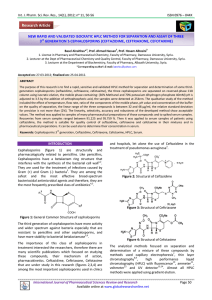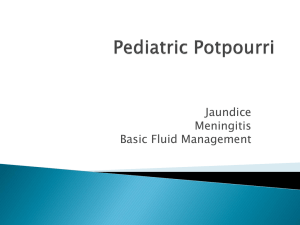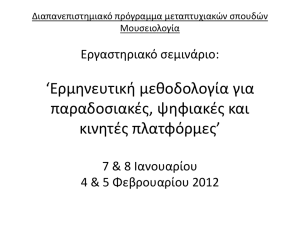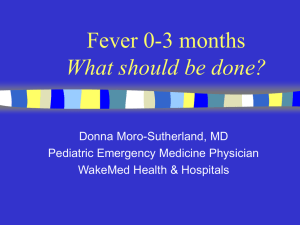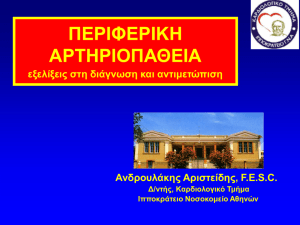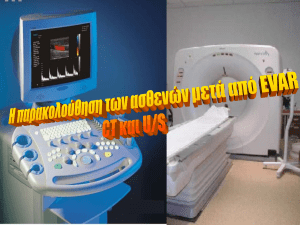Κεφαλοσπορίνες γ΄γενεάς
advertisement
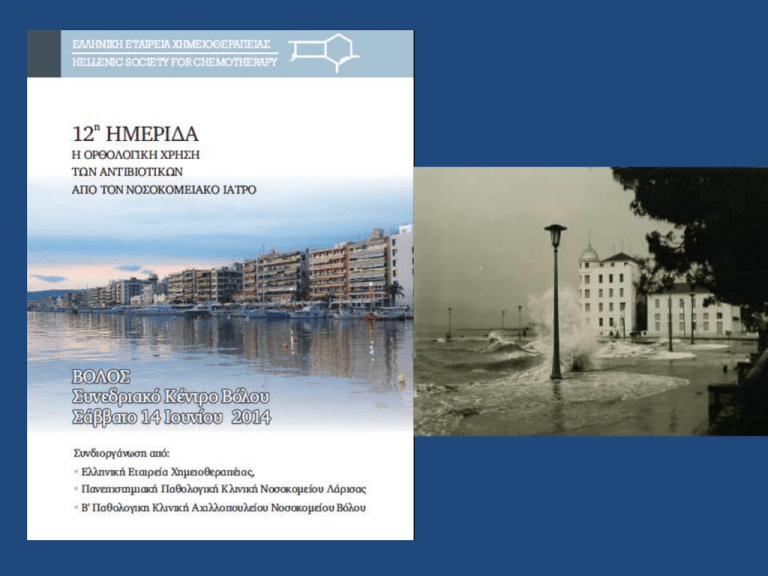
Κεφαλοσπορίνες γ΄γενεάς Άγγελος Πεφάνης ΓΝΝΘΑ «Η Σωτηρία» Oι κεφαλοσπορίνες ξεκίνησαν από ιδιαίτερα ταπεινό περιβάλλον, καθώς η πρώτη απομόνωση του μύκητα Cephalosporium acremonium, από τον Brotzu το 1945, έγινε μέσα από τα απόβλητα υπονόμων στην θάλασσα Σύνοψη χαρακτηριστικών των κεφαλοσπορινών • Βακτηριοκτόνες • Εξαιρετικά υψηλή ενδογενής δραστικότητα έναντι των εντεροβακτηριακών • Δεν είναι εξ ορισμού δραστικές: – στους εντεροκόκκους – στους MRSA και MRSE – στα αναερόβια (εξαίρεση η κεφοξιτίνη) Μηχανισμός δράσης και PK, PD • Prevents cell wall synthesis by binding to enzymes PBPs. (essential for the synthesis of the bacterial cell wall). • Concentration-independent bactericidal activity, with maximal killing at 4-5 times the MIC of the organism. • No clinically significant post-antibiotic effect Given these pharmacodynamic properties, optimal dosing regimens should be designed to continuously maintain drug levels above the MIC of pathogens. Cmax β-λακταμικά αντιβιοτικά AUC MIC Χρόνος T>MIC Κεφαλοσπορίνες γ΄γενεάς • Cefixime - CEFTORAL (PO) • Cefditoren pivoxil – SPECTRACEF (PO) • Ceftriaxone - ROCEPHIN (IV, IM) • Cefotaxime - CLAFORAN (IV) • Ceftazidime - SOLVETAN (IV) Κεφαλοσπορίνες γ΄γενεάς Χορηγούμενες από του στόματος Φαρμακοκινητικά Χαρακτηριστικά Cephalosporin Cefixime Cefditoren Peak serum Serum Route of Adult dose concentration protein excretion (μg/mL) binding (%) 200-400 mg q12-24h 200-400 mg q12h Oral bioavailabilty 1,5 – 3,0 70 Νεφρική 22-54% 2,5 (200 mg) 88 Νεφρική 17% Cefditoren pivoxil SPECTRACEF Ταχεία βακτηριοκτόνος δράση vs S. pneumoniae (PRSP) 1.00E+10 1.00E+09 control CFU/ml (log10) 1.00E+08 1.00E+07 cefditoren 1.00E+06 cefixime 1.00E+05 cefuroxime 1.00E+04 cefaclor 1.00E+03 amoxicillin/ clavlanate 1.00E+02 1.00E+01 1.00E+00 0 2 4 6 12 24 Time (hours) Dubois J et al, Diagnostic Microbiology and Infectious Disease, 37;187-193,2000 Plasma Concentration (mg/mL) 10 Cefditoren Plasma concentration 400 mg/man 200 mg/man MIC90 (mg/mL) 1 0.1 0.015 0.01 0.001 0 2 4 6 8 10 Time after administration (h) 12 Plasma Concentration-Time Profiles and Cefditoren MIC90 for H. influenzae Plasma Concentration (mg/mL) 10 Cefditoren Plasma concentration 400 mg/man 200 mg/man MIC90 (mg/mL) 1 1.0 PRSP 0.5 PISP 5.0 h 5.2 h Plasma Concentration-Time Profiles and Cefditoren 0.1 0.03 PSSP 10.6 h 0.01 MIC90 for S. pneumoniae (PRSP, PISP, PSSP) 0.001 0 2 4 6 8 10 Time after administration (h) 12 In vitro efficacy of cefditoren against recent isolates of Streptococcus pneumoniae in Greece G. Poulakou, et al. 17th ECCMID 2007. (P. 2029) • 261 στελέχη S. pneumoniae (2004-2006). • Κλινικά δείγματα από ενηλίκους και παιδιά και φαρυγγικά δείγματα από υγιή παιδιά. • Ελέγχθηκε η ευαισθησία σε PEN, ERY με E-test. • Η ευαισθησία στο cefditoren (CFD) ελέγχθηκε με τεχνική διάχυσης σε agar. • Στελέχη με MIC > 2mg/L θεωρήθηκαν ανθεκτικά. In vitro efficacy of cefditoren against recent isolates of Streptococcus pneumoniae in Greece G. Poulakou, et al. 17th ECCMID 2007. (P. 2029) • Σε 124 PEN-μη ευαίσθητα στελέχη η MIC90 του cefditoren ήταν 1 mg/L (εύρος: 0.008 - 4mg/L) • Σε 137 PEN-ευαίσθητα στελέχη η MIC90 του cefditoren ήταν 0.034mg/L (εύρος: 0.008 - 0.5mg/L). • p<0.001 Ceftidoren tablets 200 - 400 mg EΓΚΕΚΡΙΜΕΝΕΣ ΕΝΔΕΙΞΕΙΣ ΣΤΗΝ ΕΛΛΑΔΑ • Οξεία φαρυγγοαμυγδαλίτιδα 200 mg bid για 10 ημ. • Οξεία ιγμορίτιδα 200 mg bid για 10 ημ. • Παροξύνσεις χρονίας βρογχίτιδας 200 mg bid, για 5 ημ. • Ήπια ως μέτριας βαρύτητας πνευμονία κοινότητας 400 mg bid για 14 ημέρες • Μη επιπλεγμένες λοιμώξεις δέρματος και μαλακών μορίων 200 mg bid για 10 ημέρες ΕΟΦ 2006 Type of Adverse Drug Reaction (Ceftidoren tabl. 200-400 mg) No. of patients investigated ~ 6000 Incidence (%) ~ 24 % Discontinuation of Rx 2.6 % Type of ADRs Skin and Appendages Gastro Intestinal System Central & Peripheral Nervous system Dermatitis Solaris, Erythema, Erythema urticarial, Urticaria, Pruritus, Pruritus facial, Itching, Rash Diarrhoea, Abdominal pain, Nausea, Vomiting, Stools watery, Thirst, Sromach fullness, Heartburn, Anorexia, Constipation, Abdomen enlarged feeling, Defecation frequency increased, Stomatitis aphthous Headache, Vertigo, Coldness, Dizziness Cefixime proxetil CEFTORAL Cefixime proxetil • Λοιμώξεις ουροφόρων οδών • Λοιμώξεις ανώτερου αναπνευστικού • Λοιμώξεις κατώτερου αναπνευστικού Δοσολογία The recommended adult dosage is: • 200-400 mg daily (according to the severity of infection) given • either as a single dose • or in two divided doses. Κεφαλοσπορίνες της γ΄ γενεάς Per os Οι κύριες ενδείξεις χορηγήσεώς τους είναι: 1. Νοσοκομειακές λοιμώξεις για τις οποίες χορηγήθηκαν παρεντερικώς κεφαλοσπορίνες γ΄ γενεάς και απαιτείται κατ’ οίκον συνέχιση της θεραπευτικής αγωγής (μείωση διαρκείας νοσοκομειακής νοσηλείας). 2. Ουρολοιμώξεις από πολυανθεκτικούς Gram αρνητικούς μικροοργανισμούς (σύμφωνα με το αντιβιόγραμμα) 3. Πνευμονία της κοινότητας (Spectracef); Κεφαλοσπορίνες γ΄γενεάς Χορηγούμενες παρεντερικά Ceftriaxone Ceftriaxone IV/IM 1-2 g, q12-24h 50-100 q12-24h Cefotaxime Cefotaxime IV/IM 1-2 g, q 4-8h 100-180 q4 Ceftazidime Ceftazidime IV/IM 1-2 g, q8-12h 90-150 q8h Φαρμακοκινητικά Χαρακτηριστικά Adult dose Cefotaxime Ceftriaxone Ceftazidime 1-2 g q12h 1-2 g q12-24h 1-2 g q8-12h Peak serum Half-life concentr. (hr) (μg/mL) Serum protein binding (%) 102 (1 g) 1-1.2 35-40 145 (1 g) 6.4 85-95 107 (1 g) 1.5-2 Route of excretion 17 R (50-80%) R (50%) H (40%) R (80-90%) CSF concentr. range (μg/mL) 1-83 2-20 1.4-30 Δοσολογία επί νεφρικής ανεπαρκείας Cephalosporin Usual adult dosing regimen Dosing regimen with renal insufficiency (GFR: mL/min) <10 10-50 50-90 Dosing regimen with dialysis Hemodialysis CAPD Cefotaxime 2 g q8h 2 g q24h 2g q12h NC 1 g after 1 g q24h Ceftriaxone 1 g q24h NC NC NC None NC Ceftazidime 2 g q8h 2 g q12h 1 g after 0.5 q24h 0.5 g q24h 2g q24h Cmax β-λακταμικά αντιβιοτικά AUC MIC Χρόνος T>MIC Κεφταζιδίμη: συνεχής έγχυση Lubasch et al. JAC 2003;51: 659-664 Κεφαλοσπορίνες γ΄γενεάς Αντοχή Μηχανισμοί αντοχής 1. Destruction of beta-lactam ring by β-lactamases 2. Altered affinity of cephalosporins for their target site, the penicillin binding proteins (PBPs) 3. Reduced penetration of the antibiotic through the LPS membrane to the PBP target [Gram(-) bacteria] 4. Efflux of the drug from the periplasmic space (MexAB-OprM efflux pump for ceftazidime) It is not uncommon for several resistance mechanisms to be operating simultaneously. Αλλαγές στις PBPs Changes in the PBP target are responsible for reduced Cephalosporin affinity and subsequent drug resistance for: • • • • S. pneumoniae, MRSA, H. influenzae, Neisseria gonorrhoeae (some strains) Κεφαλοσπορίνες γ΄γενεάς …και το πρόβλημα των ESBL ESBLs και κεφαλοσπορίνες • Υπάρχουν ESBL (+) στελέχη που είναι ευαίσθητα in vitro στις κεφαλοσπορίνες β΄γενεάς αλλά ανθεκτικά στη κεφταζιδίμη. • Εν τούτοις, οι κεφαλοσπορίνες β΄και γ΄ γενεάς δεν είναι κλινικά αποτελεσματικές έναντι αυτών των στελεχών. Παράγοντες κινδύνου για ESBLs • Σοβαρά πάσχοντες με παρατεταμένη νοσηλεία. • Διατήρηση για μεγάλο χρονικό διάστημα, καθετήρα κύστεως, ενδοτραχειακού σωλήνα, κεντρικής φλεβικής γραμμής, ρινογαστρικού σωλήνα, γαστροστομίας και νηστιδοστομίας. • Διαμονή σε οίκους ευγηρίας. • Παροδικός αποικισμός των χεριών του προσωπικού. • Χορήγηση κεφαλοσπορινών γ΄ γενεάς ή αζτρεονάμης Κεφταζιδίμη: παράγων κινδύνου για ESBL • Study of hospitalized patients in Taiwan, • The risk of infection with ESBL-producing K. pneumoniae was 13 times greater among patients who had been exposed to ceftazidime within the prior 30 days than it was among patients who had not been similarly exposed. Lin MF, et al. J Hosp Infect 2003; 53:39–45. Κεφαλοσπορίνες γ΄γενεάς 2010: Η CLSI αλλάζει τα breakpoints CLSI M100-S20 (2010) Cephalosporin and Aztreonam Breakpoint Revisions for Enterobacteriaceae MIC breakpoints (μg/ml): Agent Old (M100-S19) Susc Int Res Revised (M100-S20) Susc Int Res Cefotaxime ≤8 16-32 ≥64 ≤1 2 ≥4 Ceftriaxone ≤8 16-32 ≥64 ≤1 2 ≥4 Ceftazidime ≤8 16 ≥32 ≤4 8 ≥16 Aztreonam ≤8 16 ≥32 ≤4 8 ≥16 Why were cephalosporin breakpoints for the Enterobacteriaceae revised? The revised breakpoints eliminate the need to perform ESBL screen and confirmatory tests for making treatment decisions. Αντοχή των Gram(-) στη Ceftazidime WHONET July - December 2009 Ceftazidime non-susceptible Acinetobacter baumanii 86 – 97 Pseudomonas aeruginosa 27 – 50 Enterobacter spp 32 – 40 Klebsiella pneumoniae 40 – 83 Proteus mirabilis 19 – 57 E. coli 8 – 12 Κεφαλοσπορίνες γ΄γενεάς Ανεπιθύμητες Ενέργειες Ανεπιθύμητες Ενέργειες • Immunologically mediated reactions may manifest as hematologic or renal toxicities. • Eosinophilia is the most commonly reported. • Although Coombs (+) are reported to a significant percentage of patients receiving many of the cephalosporins, these patients most often do not have hemolytic anemia. • Ιnterstitial nephritis Ανεπιθύμητες Ενέργειες • Αφυλακτικές αντιδράσεις σπανιότερες από την πενικιλλίνη G. • Διασταυρούμενες αντιδράσεις υπερευαισθησίας με τις πενικιλλίνες στο 5-7% των περιπτώσεων. • Εκδηλώνονται κυρίως υπό μορφή εξανθημάτων Risk of anaphylaxis with cephalosporins • The frequently cited figure of 10% cross reactivity between penicillin and cephalosporins is an overestimate. • Cross reactivity between penicillins and 2nd and 3rd generation cephalosporins is low and may be lower than the cross reactivity between penicillins and unrelated antibiotics. Risk of anaphylaxis with cephalosporins The risk of anaphylaxis with cephalosporins is low, between 0.1% and 0.0001% based on a retrospective analysis of toxicity data from 210 clinical trials involving 2539 pts receiving ceftazidime and on post-marketing surveillance data. Lin RY. Arch Intern Med 1992:930-7. In patients allergic to penicillin the OD for an allergic reaction to a: • 1st generation cephalosporine or cefamandole are 4.79 (95%, CI: 3.71 to 6.17) • 2nd generation cephalosporin are 1.13 (CI: 0.61 to 2.12) and • 3rd generation cephalosporins are 0.45 (0.18 to 1.13) Pichichero ME, Casey JR. Otolaryngol Head Neck Surg 2007;136:340-7. Συμπέρασμα 1 2nd and 3rd generation cephalosporins, such as ceftriaxone, cefotaxime, cefuroxime, ceftazidime, are unlikely to be associated with cross reactivity as they have different side chains to penicillin. Scott Pegler, Brendan Healy. BMJ 2007;335:991 Συμπέρασμα 2 In life threatening infections, when use of a non-cephalosporin antibiotic would be suboptimal, consider giving, under observation, a 2nd or 3rd generation cephalosporin with a different side chain to the penicillin under suspicion. Scott Pegler, Brendan Healy. BMJ 2007;335:991 Κεφαλοσπορίνες γ΄γενεάς Κλινικές ενδείξεις Θεραπευτικές ενδείξεις Κεφτριαξόνης Θεραπευτικές ενδείξεις Κεφτριαξόνης Θεραπευτικές ενδείξεις Κεφταζιδίμης Κλινικές Ενδείξεις Μηνιγγίτιδα Εμπειρική θεραπεία μηνιγγίτιδας Ηλικία Θεραπεία <1 μήνα Ampicillin + cefotaxime Ampicillin + aminoglycoside 1-23 μήνες γ΄ γενεάς κεφαλοσπορίνη a + Vancomycin 2-50 έτη γ΄ γενεάς κεφαλοσπορίνη a + Vancomycin >50 ετών γ΄γενεάς κεφαλοσπορίνη a + ampicillin + Vancomycin a cefotaxime ή ceftriaxone Θεραπεία μηνιγγίτιδας ανάλογα με το παθογόνο Παθογόνο Θεραπεία S. pneumoniae γ΄ γενεάς κεφαλοσπορίνη a N. meningitidis Penicillin G, ή ampicillin, ή γ΄ γενεάς κεφαλοσπορίνη a L. monocytogenes Ampicillin ή penicillin G b a c cefotaxime ή ceftriaxone + aminoglycoside Θεραπεία μηνιγγίτιδας ανάλογα με το παθογόνο Θεραπεία Neisseria meningitidis - PCN MIC <0.1 mg/mL - PCN MIC 0.1-1.0 mg/m Penicillin G ή ampicillin γ΄ γενεάς κεφαλοσπορίνηa Haemophilus influenzae - b-lactamase-negative - b-lactamase-positive a cefotaxime ή ceftriaxone Ampicillin γ΄ γενεάς κεφαλοσπορίνηa Θεραπεία πνευμονιοκοκκικής μηνιγγίτιδας Απαραίτητη η γνώση της MIC-πενικιλλίνης του στελέχους S. pneumoniae που απομονώθηκε στην καλλιέργεια ΕΝΥ (ή/και στην αίμοκαλλιέργεια). • MIC < 0.1 πενικιλλίνη ή αμπικιλλίνη • MIC=0,1 - 1 κεφτριαξόνη ή κεφοταξίμη • MIC > 1 κεφτριαξόνη ή κεφοταξίμη Aν MICκεφτριαξόνης > 0.5 βανκομυκίνη + κεφτριαξόνη Αντοχή του S. pneumoniae σε Ceftriaxone ή Cefotaxime • Antimicrobial resistance of Streptococcus pneumoniae isolates in Athens, Greece. Kanavaki S, et al. Eur J Clin Microbiol Infect Dis. 2005;24:693-6. 0,36% • Serotypes and antimicrobial susceptibilities of 1033 pneumococci isolated from children in Greece:2001-2004 Paraskakis I, et al. Clin Microbiol Infect. 2006;12:490-3. 1,2% • Nationwide surveillance of S. pneumoniae in Greece: Poulakou G, et all. Int J Antimicrob Agents. 2007;30:87-92 1% Ενδείξεις χορήγησης σύμφωνα με τον Mandell 7th Edition Ενδείξεις Ceftazidime • For serious infections in which P. aeruginosa is documented or highly likely. • It is one of the recommended drugs, + aminoglycoside, for initial empirical management of febrile neutropenia. Ενδείξεις Ceftazidime • Ceftazidime has been effective for the Rx of acute exacerbations of chronic pulmonary infections in patients with cystic fibrosis. • The drug penetrates into CSF and is the Rx of choice for meningitis due to P. aeruginosa. Ενδείξεις Ceftriaxone - Cefotaxime • Cefotaxime and ceftriaxone continue to be active against most bacteria producing CAP. • In a large observational study of pneumococcal bacteremia, resistance to cefotaxime and ceftriaxone was not associated with higher mortality. • Cefotaxime and ceftriaxone were also effective in treating patients with non-meningeal pneumococcal infections, mostly pneumonia, caused by strains with MICs as high as 2 μg/mL Ενδείξεις Ceftriaxone - Ωτίτιδα • Single ΙΜ doses of ceftriaxone are also highly effective in eradicating H. influenzae and penicillin-susceptible strains of S. pneumoniae from middle ear fluid. • However, three daily doses of ceftriaxone were required in one study to eradicate penicillin-resistant pneumococci Ενδείξεις Ceftriaxone - STDs • Ηighly active against N. gonorrhoeae, including penicillin- and quinolone-resistant strains. • It is the drug of choice for all forms of gonococcal infection and is used in combination with doxycycline for pelvic inflammatory disease, proctitis, and proctocolitis. • Single-dose ΙΜ ceftriaxone is recommended therapy for chancroid. • Ceftriaxone is considered as alternative therapy in penicillin-allergic patients with syphilis. Ενδείξεις Ceftriaxone - Lyme disease • Ceftriaxone and cefotaxime are recommended therapy for treatment of early Lyme disease in patients with neurologic involvement or thirddegree atrio-ventricular heart block. • These drugs are also recommended in Lyme disease patients with both arthritis and objective evidence of neurologic disease and for those with late neurologic disease affecting the central or peripheral nervous system. Ενδείξεις Ceftriaxone • Ceftriaxone is a recommended alternative therapy for typhoid fever and for severe infections caused by Shigella species or by nontyphi species of Salmonella. • Single doses of ceftriaxone are highly effective in eradicating nasopharyngeal carriage of N. meningitidis. • Βrain abscess caused by gram-negative bacilli. Ενδείξεις Ceftriaxone • It has been effective for the outpatient Rx of staphylococcal and streptococcal skin and soft tissue infections, including osteomyelitis. • Εffective as monotherapy for the outpatient Rx of non-enterococcal streptococcal endocarditis. • Recommended in endocarditis caused by fastidious gram-negative coccobacilli. Ευχαριστώ Κεφαλοσπορίνες γ’ γενεάς Ερωτήσεις Περίπτωση 1η • Γυναίκα 67 ετών, παχύσαρκη, γραμματέας • Εξετάζεται στο ΤΕΠ την 9η Φεβρουαρίου • Ιστορικό: - Διάρροιες από 2ημέρου - Μη παραγωγικός βήχας από 4ημέρου - Πλευριτικού τύπου πόνος από 24ώρου - Δεν αναφέρεται πυρετός ή ρίγος Περιγραφή περίπτωσης • Καπνίστρια: 30 πακέτα/έτη • Χωρίς υποκείμενα νοσήματα • ΑΠ: 110/60mmHg, με μικρή μεταβολή στην όρθια θέση • Θ: 38,40 C • Αναπνοές: 28/λεπτό • Τρίζοντες στις βάσεις άμφω, μουσικοί ρόγχοι στα ανώτερα πνευμονικά πεδία Περιγραφή περίπτωσης • • • • • • Α/α θώρακος: + (πιθανές πυκνώσεις, άμφω) pO2 = 55mmHg Sat = 89% Λευκά = 10,400 (πόλυ = 78%) Σάκχαρο = 320 mg/dl Έναρξη αγωγής με κεφουροξίμη 750mg x 3 και κλαριθρομυκίνη 500mg x 2, IV Περιγραφή περίπτωσης • 36 ώρες αργότερα η κατάσταση εξακολουθεί να επιδεινώνεται. • Νέα α/α θώρακος με αμφοτερόπλευρες πυκνώσεις. • Αλλαγή αγωγής σε κεφτριαξόνη (2g x 1), ριφαμπικίνη (600mg x 1) και ερυθρομυκίνη (500mg x 4), όλα IV Περιγραφή περίπτωσης • 24 ώρες αργότερα οι καλλιέργειες αίματος εισαγωγής αναφέρονται θετικές για πνευμονιόκκοκο. • Το στέλεχος έχει MIC-πενικιλλίνης: 4μg/ml και MIC-κεφτριαξόνης: 0,25μg/ml. • Ποία είναι η πιο πιθανή εξήγηση για τη κλινική αποτυχία του αρχικού σχήματος Ερώτηση 1: Ποία είναι η πιο πιθανή εξήγηση για τη κλινική αποτυχία του αρχικού σχήματος 1. 2. 3. 4. Ακατάλληλη αγωγή (guidelines) Ανεπαρκής δοσολογία Αντοχή στη πενικιλλίνη (στέλεχος PRSP) Όλα τα ανωτέρω Περίπτωση 2η • Ασθενής 65 ετών με κλινική και εργαστηριακή εικόνα μικροβιακής μηνιγγίτιδας • Gram χρώση: Gram(+) διπλόκοκκοι Ερώτηση 2η: Τι αγωγή θα προτείνατε; 1. 2. 3. 4. Πενικιλλίνη γ΄ γενεάς κεφαλοσπορίνη + Αμπικιλλίνη γ΄ γενεάς κεφαλοσπορίνη + Vancomycin Μεροπενέμη Περίπτωση 3η • Ασθενής με ενδοκαρδίτιδα φυσικής βαλβίδας από Enterococcus faecalis. • Ο ασθενής λαμβάνει συνδυασμό αμπικιλλίνης (2g x 6) και γενταμικίνης (80mg x 3). • Το αντιβιόγραμμα δείχνει ότι το στέλεχος είναι ευαίσθητο στη πενικιλλίνη, αλλά έχει MIC γενταμικίνης >500 mg/L • Την 8η ημέρα θεραπείας ο ασθενής εξακολουθεί να έχει πυρετό. Ερώτηση 3: Τι θεραπεία θα προτείνατε; 1. 2. 3. 4. 5. Νταπτομυκίνη Λινεζολίδη Βανκομυκίνη με Γενταμικίνη Αμπικιλλίνη με Κεφτριαξόνη Αμπικιλλίνη με Νταπτομυκίνη Κλινική επιτυχία 67% Αμπικιλλίνη: 2g x 6 x 6 εβδομάδες + Κεφτριαξόνη: 2g x 2 x 6 εβδομάδες (επιτυχία 67%) Annals of Internal Medicine 2007;146:574 Περίπτωση 4η • Ασθενής 77 ετών με πρόσφατη νοσηλεία στο νοσοκομείο λόγω γαστρορραγίας, όπου είχε τεθεί ουροκαθετήρας για 10 ημέρες. • Εισάγεται με κλινική διάγνωση πυελονεφρίτιδας • Την επομένη, στις κ/ες αίματος και ούρων απομονώνεται E. coli • Την επομένη ημέρα το αντιβιόγραμμα δείχνει τις παρακάτω ευαισθησίες Ε. coli • • • • • • • • • • • Αmpicillin: Cephalothin: Augmentin: Cefoxitin: Ceftazidime: Cefotaxime: Imipenem: Gentamicin: Amikacin: Nalidixic Acid: Norfloxacin: A A E E Ε A E E E E E Ερώτηση 4: Υπάρχει εξήγηση για αυτό το pattern ευαισθησίας; 1. 2. 3. 4. 5. Υπερπαραγωγή β-λακταμάσης TEM-1 Παραγωγή MBL (μέταλο-β-λακταμάσης) Παραγωγή ESBL Εργαστηριακό λάθος Δεν γνωρίζω Ερώτηση 4 Ποία είναι η πιο κατάλληλη θεραπεία; 1. 2. 3. 4. 5. Αμοξικιλλίνη-κλαβουλανικό Πιπερακιλλίνη - ταζομπακτάμη Κεφταζιδίμη Σιπροφλοξασίνη Ιμιπενέμη Περίπτωση 5η • A previously healthy 19y old woman was referred for evaluation of possible chronic Lyme disease. • The pt was given 2 g ceftriaxone IV qD for 14 days. • One week after the Rx was completed, she noted the onset of severe pain in the right upper quadrant and had a temperature of 39.4o C and vomiting. • Sonography showed multiple gallstones. Ερώτηση 5: Πως εξηγείται η κλινική εικόνα της ασθενούς; 1. Απλή χολοκυστίτιδα 2. Χολολιθίαση επί εδάφους αιμοσφαιρινοπάθειας 3. Κλινική εκδήλωση της Χρόνιας Νόσου Lyme 4. Ψεύδολιθίαση Βiliary pseudolithiasis • The patient was not obese, nor was there a family history of gallbladder disease. • Because of the recent ceftriaxone use, she was observed without specific therapy. • A second sonographic examination 3 weeks later showed a normal gallbladder with complete disappearance of the stones. Βiliary pseudolithiasis • 73 reports of pseudolithiasis occurring during or after ceftriaxone therapy. • 16 of these patients underwent cholecystectomy, which revealed a sand-like sediment or semisolid particles in the gallbladder, without stones. • 57 patients were managed conservatively, • and of these, 75% had follow-up sonograms that did not show gallstones within 3 months Βiliary pseudolithiasis • Ceftriaxone is the only third-generation cephalosporin to cause these precipitates. • The probable reason for this observation is that ceftriaxone is the only cephalosporin that complexes with calcium in bile. Βiliary pseudolithiasis • It appears that with the use of high doses, the solubility of the drug is exceeded, causing the formation of Ca-ceftriaxone salt precipitates. • At doses less than 1 g/day, precipitates have not been shown to occur. Βiliary pseudolithiasis • The key to the diagnosis of this entity will not lie with the sonographic findings but • with the physician suspecting that gallstones are unlikely in a particular patient, such as a child or young adult. Βiliary pseudolithiasis • It is crucial to question the patient regarding recent Ceftriaxone use when making the diagnosis of biliary pseudolithiasis. • The correct diagnosis will spare patients needless treatment, such as cholecystectomy, for this spontaneously reversible abnormality. Kirejczyk WM, et al. AJR 1992;159:329-330. Ευχαριστώ

